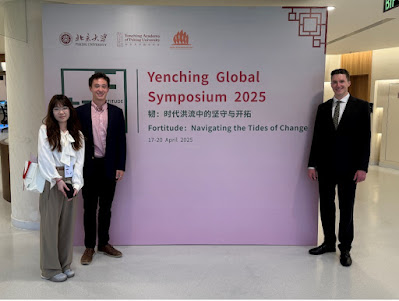Volunteer Teaching in Nanjing
Student blogger Cady Deck, Certificate ’19, shares her experience volunteer teaching at a local elementary school in Nanjing.
This semester, I am one of four international students volunteering as an English teacher at Xijie Elementary School. I talked with Paul Armstrong-Taylor, an economics professor at the Hopkins-Nanjing Center and our volunteer teaching faculty advisor, to learn about the school and how the volunteer teaching program began. The program started in 2010 when he and a first-year master’s student, “realized that many students were interested in volunteering, but because they were only at the Hopkins-Nanjing Center for one or two years it was often hard to connect with opportunities.” They reached out to a major Chinese non-profit based in Nanjing, who put them in contact with a local elementary school. Although they began teaching at that elementary school, the school that students volunteer at has changed several times over the years.

We teach a class of about 30 students on Friday afternoons, which presents a unique challenge. As a former third grader, I sympathize with their desire to start the weekend, but as a teacher, their excitement is my biggest challenge. The four of us are tasked with teaching them new material, reviewing what they have already learned, and maintaining control of the class, all in the span of 40 minutes. As a result, not only are we developing our teaching skills, but we’re also gaining classroom management skills. At the beginning of the semester, I saw a volunteer teaching WeChat QR code posted on the Hopkins-Nanjing Center bulletin board and immediately scanned it to sign up. For me, volunteering at this school is a fun way to interact with the local community and do something productive with my free time on Fridays.
Volunteer teaching is a very rewarding experience, even though we only teach for 40 minutes every time. We meet before each class to come up with new lesson plans. The first time we went, we weren’t sure what level the students were at, so we came up with activities based on the first few lessons in their textbook, which consisted of very basic greetings, such as “hello” and “good morning.” After teaching them for a few minutes, we quickly realized they were at a much more advanced level. We needed to give them a bigger challenge, so we taught them more complex sentence structures and had them introduce themselves to each other and to us.
Because the students are so far ahead of the lessons in the textbook, we come up with our own topics every week. For example, last time we taught them about different flavors and food. We incorporate as many interactive elements as possible so they can practice speaking with and listening to native English speakers. By doing this, we correct their mistakes, and they hear how certain words should be pronounced. However, correcting pronunciation isn’t a one-way street. An unintentional benefit of this opportunity is that the students aren’t afraid to let us know when our tones are wrong or when they don’t understand our Chinese.
The Hopkins-Nanjing Center emphasizes the importance of cross-cultural dialogue, and this is a great way to engage with people of different ages and backgrounds. Professor Armstrong-Taylor summed up the overall experience perfectly by saying that “we not only get the psychological benefits of helping others, but also an opportunity to get out of the Hopkins-Nanjing Center bubble and see a part of Nanjing and Chinese society that we would not otherwise have access to.”
Written by Cady Deck, Hopkins-Nanjing Center Certificate ’19
This semester, I am one of four international students volunteering as an English teacher at Xijie Elementary School. I talked with Paul Armstrong-Taylor, an economics professor at the Hopkins-Nanjing Center and our volunteer teaching faculty advisor, to learn about the school and how the volunteer teaching program began. The program started in 2010 when he and a first-year master’s student, “realized that many students were interested in volunteering, but because they were only at the Hopkins-Nanjing Center for one or two years it was often hard to connect with opportunities.” They reached out to a major Chinese non-profit based in Nanjing, who put them in contact with a local elementary school. Although they began teaching at that elementary school, the school that students volunteer at has changed several times over the years.

We teach a class of about 30 students on Friday afternoons, which presents a unique challenge. As a former third grader, I sympathize with their desire to start the weekend, but as a teacher, their excitement is my biggest challenge. The four of us are tasked with teaching them new material, reviewing what they have already learned, and maintaining control of the class, all in the span of 40 minutes. As a result, not only are we developing our teaching skills, but we’re also gaining classroom management skills. At the beginning of the semester, I saw a volunteer teaching WeChat QR code posted on the Hopkins-Nanjing Center bulletin board and immediately scanned it to sign up. For me, volunteering at this school is a fun way to interact with the local community and do something productive with my free time on Fridays.
Volunteer teaching is a very rewarding experience, even though we only teach for 40 minutes every time. We meet before each class to come up with new lesson plans. The first time we went, we weren’t sure what level the students were at, so we came up with activities based on the first few lessons in their textbook, which consisted of very basic greetings, such as “hello” and “good morning.” After teaching them for a few minutes, we quickly realized they were at a much more advanced level. We needed to give them a bigger challenge, so we taught them more complex sentence structures and had them introduce themselves to each other and to us.
Because the students are so far ahead of the lessons in the textbook, we come up with our own topics every week. For example, last time we taught them about different flavors and food. We incorporate as many interactive elements as possible so they can practice speaking with and listening to native English speakers. By doing this, we correct their mistakes, and they hear how certain words should be pronounced. However, correcting pronunciation isn’t a one-way street. An unintentional benefit of this opportunity is that the students aren’t afraid to let us know when our tones are wrong or when they don’t understand our Chinese.
The Hopkins-Nanjing Center emphasizes the importance of cross-cultural dialogue, and this is a great way to engage with people of different ages and backgrounds. Professor Armstrong-Taylor summed up the overall experience perfectly by saying that “we not only get the psychological benefits of helping others, but also an opportunity to get out of the Hopkins-Nanjing Center bubble and see a part of Nanjing and Chinese society that we would not otherwise have access to.”
Written by Cady Deck, Hopkins-Nanjing Center Certificate ’19


